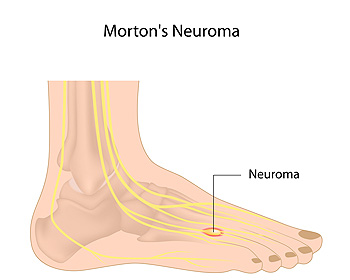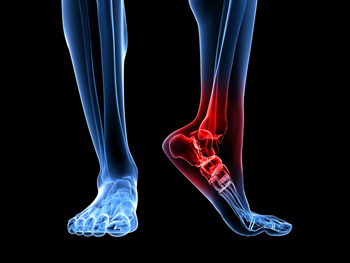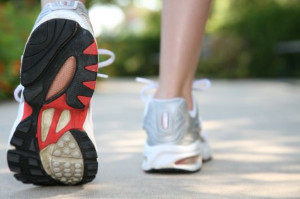Items filtered by date: November 2019
Who is Prone to Developing Morton’s Neuroma?
 If you are experiencing pain on the ball of the foot, it may be indicative of a condition that is referred to as Morton’s neuroma. It is typically caused by irritation that happens to a nerve connected to a toe. It can become thickened, and will most often occur between the second and third toes. It may be common among patients who have flat feet, high arches, or conditions that can include bunions and hammertoes. People who enjoy sporting activities that involve running may also be susceptible to developing this condition. Additionally, skiers or ballerinas may be prone to getting Morton’s neuroma as a result of wearing shoes that put pressure on the ball of the foot. Symptoms that are often associated with this ailment can include a numbing and tingling sensation, and pain or difficulty walking. If you suffer from this condition, please consult with a podiatrist who can properly treat this condition.
If you are experiencing pain on the ball of the foot, it may be indicative of a condition that is referred to as Morton’s neuroma. It is typically caused by irritation that happens to a nerve connected to a toe. It can become thickened, and will most often occur between the second and third toes. It may be common among patients who have flat feet, high arches, or conditions that can include bunions and hammertoes. People who enjoy sporting activities that involve running may also be susceptible to developing this condition. Additionally, skiers or ballerinas may be prone to getting Morton’s neuroma as a result of wearing shoes that put pressure on the ball of the foot. Symptoms that are often associated with this ailment can include a numbing and tingling sensation, and pain or difficulty walking. If you suffer from this condition, please consult with a podiatrist who can properly treat this condition.
Morton’s neuroma is a very uncomfortable condition to live with. If you think you have Morton’s neuroma, contact Dr. Kendall Blackwell of InStride Wilson Podiatry Associates. Our doctor will attend to all of your foot care needs and answer any of your related questions.
Morton’s Neuroma
Morton's neuroma is a painful foot condition that commonly affects the areas between the second and third or third and fourth toe, although other areas of the foot are also susceptible. Morton’s neuroma is caused by an inflamed nerve in the foot that is being squeezed and aggravated by surrounding bones.
What Increases the Chances of Having Morton’s Neuroma?
- Ill-fitting high heels or shoes that add pressure to the toe or foot
- Jogging, running or any sport that involves constant impact to the foot
- Flat feet, bunions, and any other foot deformities
Morton’s neuroma is a very treatable condition. Orthotics and shoe inserts can often be used to alleviate the pain on the forefront of the feet. In more severe cases, corticosteroids can also be prescribed. In order to figure out the best treatment for your neuroma, it’s recommended to seek the care of a podiatrist who can diagnose your condition and provide different treatment options.
If you have any questions, please feel free to contact our office located in Wilson, NC . We offer the newest diagnostic and treatment technologies for all your foot care needs.
Can Practicing Yoga Help to Prevent Running Injuries?
Research has indicated it is beneficial to perform specific stretching techniques that may be helpful in preventing running injuries. It is wise to choose running shoes that fit correctly, assuring the heel and toes feel comfortable. The joints, muscles, and tendons can remain flexible when yoga is routinely practiced, which may help to increase the enjoyment of running. Additionally, many runners practice strength training, this can keep the muscles strong which may add to endurance. Any tension that is present may be alleviated when a massage is performed, helping this to aid the body in feeling relaxed. If you are contemplating the sport of running, it is suggested that you speak to a podiatrist who can advise you on how to prevent running injuries.
All runners should take extra precaution when trying to avoid injury. If you have any concerns about your feet, contact Dr. Kendall Blackwell of InStride Wilson Podiatry Associates. Our doctor will treat your foot and ankle needs.
How to Prevent Running Injuries
There are a lot of mistakes a runner can make prior to a workout that can induce injury. A lot of athletes tend to overstretch before running, instead of saving those workouts for a post-run routine. Deep lunges and hand-to-toe hamstring pulls should be performed after a workout instead of during a warmup. Another common mistake is jumping into an intense routine before your body is physically prepared for it. You should try to ease your way into long-distance running instead of forcing yourself to rush into it.
More Tips for Preventing Injury
- Incorporate Strength Training into Workouts - This will help improve the body’s overall athleticism
- Improve and Maintain Your Flexibility – Stretching everyday will help improve overall performance
- “Warm Up” Before Running and “Cool Down” Afterward – A warm up of 5-10 minutes helps get rid of lactic acid in the muscles and prevents delayed muscle soreness
- Cross-Training is Crucial
- Wear Proper Running Shoes
- Have a Formal Gait Analysis – Poor biomechanics can easily cause injury
If you have any questions, please feel free to contact our office located in Wilson, NC . We offer the newest diagnostic and treatment technologies for all your foot care needs.
Ankle Sprains May Be Common Among Athletes
 Research has shown that ankle sprains are common among people who frequently participate in sporting activities. This is often the result of tearing or overstretching the ligaments in the ankle. Common symptoms of this type of injury may include severe swelling, pain, and it may be difficult to put weight on the ankle. Relief may be found when the affected foot is elevated, and this may help to alleviate a portion of the swelling. Additionally, it may be beneficial to wrap the ankle in an elastic bandage, and this can help to provide the support that is needed as the healing process takes place. If the activity is resumed that caused the sprain before the ankle has had a chance to completely heal the sprain may return, and ligaments may be scarred. If you have fallen or twisted your ankle, and think it may be sprained, it is suggested that you consult with a podiatrist who can diagnosis and treat this condition.
Research has shown that ankle sprains are common among people who frequently participate in sporting activities. This is often the result of tearing or overstretching the ligaments in the ankle. Common symptoms of this type of injury may include severe swelling, pain, and it may be difficult to put weight on the ankle. Relief may be found when the affected foot is elevated, and this may help to alleviate a portion of the swelling. Additionally, it may be beneficial to wrap the ankle in an elastic bandage, and this can help to provide the support that is needed as the healing process takes place. If the activity is resumed that caused the sprain before the ankle has had a chance to completely heal the sprain may return, and ligaments may be scarred. If you have fallen or twisted your ankle, and think it may be sprained, it is suggested that you consult with a podiatrist who can diagnosis and treat this condition.
Although ankle sprains are common, they aren’t always minor injuries. If you need your ankle injury looked at, contact Dr. Kendall Blackwell from InStride Wilson Podiatry Associates. Our doctor can provide the care you need to keep you pain-free and on your feet.
How Does an Ankle Sprain Occur?
Ankle sprains are the result of a tear in the ligaments within the ankle. These injuries may happen when you make a rapid shifting movement while your foot is planted. A less common way to sprain your ankle is when your ankle rolls inward while your foot turns outward.
What Are the Symptoms?
- Pain at the sight of the tear
- Bruising/Swelling
- Ankle area is tender to touch
- In severe cases, may hear/feel something tear
- Skin discoloration
Preventing a Sprain
- Wearing appropriate shoes for the occasion
- Stretching before exercises and sports
- Knowing your limits
Treatment of a Sprain
In many cases, the RICE method (Rest, Ice, Compression, and Elevate) is used to treat ankle sprains. However, you should see a podiatrist to see which treatment option would work best with your injury. In severe cases, surgery may be required.
It is important to ask your doctor about rehab options after you receive treatment for your injury. Stretching, strength training, and balance exercises may help the ankle heal while also preventing further injury.
If you have any questions, please feel free to contact our office located in Wilson, NC . We offer the newest diagnostic and treatment technologies for all your foot care needs.
Why Choose Foot Surgery?
 Many patients choose to have foot surgery performed as an option to relieve severe pain and discomfort. Relief may be found when toenail removal is chosen to correct chronically infected ingrown toenails. Bunion surgery may be a choice to consider if the bunion is painful and unsightly. Research has indicated it is helpful to wear orthotics following a bunionectomy, as this may help to achieve long lasting relief. If pain is felt from a deformed ankle, the surgery that may help diminish the discomfort is referred to as an ankle fusion. Additionally, this type of surgery may help patients who have ankle arthritis, and neuromuscular disorders. If you have foot pain, and are considering surgery, it is strongly advised that you schedule a consultation with a podiatrist who can properly guide you toward making the choice that is correct for you.
Many patients choose to have foot surgery performed as an option to relieve severe pain and discomfort. Relief may be found when toenail removal is chosen to correct chronically infected ingrown toenails. Bunion surgery may be a choice to consider if the bunion is painful and unsightly. Research has indicated it is helpful to wear orthotics following a bunionectomy, as this may help to achieve long lasting relief. If pain is felt from a deformed ankle, the surgery that may help diminish the discomfort is referred to as an ankle fusion. Additionally, this type of surgery may help patients who have ankle arthritis, and neuromuscular disorders. If you have foot pain, and are considering surgery, it is strongly advised that you schedule a consultation with a podiatrist who can properly guide you toward making the choice that is correct for you.
Foot surgery is sometimes necessary to treat a foot ailment. To learn more, contact Dr. Kendall Blackwell of InStride Wilson Podiatry Associates. Our doctor will assist you with all of your foot and ankle needs.
When Is Surgery Necessary?
Foot and ankle surgery is generally reserved for cases in which less invasive, conservative procedures have failed to alleviate the problem. Some of the cases in which surgery may be necessary include:
- Removing foot deformities like bunions and bone spurs
- Severe arthritis that has caused bone issues
- Cosmetic reconstruction
What Types of Surgery Are There?
The type of surgery you receive will depend on the nature of the problem you have. Some of the possible surgeries include:
- Bunionectomy for painful bunions
- Surgical fusion for realignment of bones
- Neuropathy decompression surgery to treat nerve damage
Benefits of Surgery
Although surgery is usually a last resort, it can provide more complete pain relief compared to non-surgical methods and may allow you to finally resume full activity.
Surgical techniques have also become increasingly sophisticated. Techniques like endoscopic surgery allow for smaller incisions and faster recovery times.
If you have any questions please feel free to contact our office located in Wilson, NC . We offer the newest diagnostic and treatment technologies for all your foot and ankle needs.


